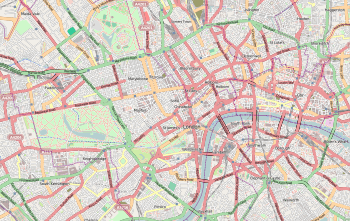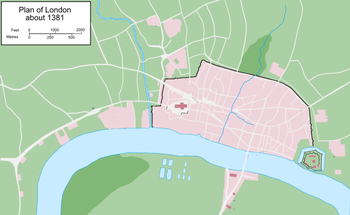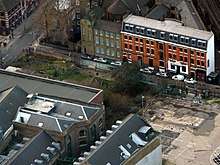Cross Bones
Cross Bones is a disused post-medieval burial ground on Redcross Way in Southwark, south London.[2] Up to 15,000 people are believed to have been buried there. It was closed in 1853.
 Cross Bones gate, September 2014 | |
  | |
| Details | |
|---|---|
| Established | Earliest mention 1598 |
| Closed | 1853 |
| Location | Redcross Way, Southwark, south London, SE1 |
| Country | England |
| Type | Prostitutes and paupers |
| Owned by | Transport for London (as of 2014)[1] |
| No. of graves | Up to 15,000 |
| Website | crossbones.org.uk |
Cross Bones is thought to have been established originally as an unconsecrated graveyard for prostitutes, or "single women", who were known locally as "Winchester Geese" because they were licensed by the Bishop of Winchester to work within the Liberty of the Clink.[1][3] The area lay outside the jurisdiction of the City of London and as a consequence became known for its brothels and theatres, as well as bull and bear baiting, activities not permitted within the City itself.[4][5] By 1769 it had become a pauper's cemetery servicing St. Saviour's parish.
History
Origins

John Stow, in his A Survey of London (1598), made mention of a "Single Woman's churchyard" in Southwark, near the Clink:
Next on this [west bank of the Thames] was sometimes the Bordello, or Stewes, a place so called of certain stew-houses privileged there, for the repair of incontinent men to the like women ... I have heard of ancient men, of good credit, report, that these single women were forbidden the rites of the church, so long as they continued that sinful life, and were excluded from Christian burial, if they were not reconciled before their death. And therefore there was a plot of ground called the Single Woman's churchyard, appointed for them far from the parish church.[6]
It was mentioned again in 1795 in a history of St. Saviour's, Southwark:
Our readers will remember that, in the account we have given of the Stews on Bank-side, mention is made of a piece of ground, called the Single Woman’s Burying Ground, set apart as the burial place of those unfortunate females; we are very much inclined to believe this was the spot, for in early times the ceremony of consecration would certainly not have been omitted; and if it had been performed, it would doubtless have appeared by some register, either in the possession of the Bishop of Winchester, or in the proper ecclesiastical court. We find no other place answering the description given of a ground appropriated as a burial place for these women, circumstances, therefore, justify the supposition of this being the place; for it was said, the ground was not consecrated; and the ordination was that they should not be buried in any spot so sanctified.[7]
The antiquarian William Taylor wrote in 1833: “There is an unconsecrated burial ground known as the Cross Bones at the corner of Redcross Street, formerly called the Single Woman's burial ground, which is said to have been used for this purpose."[1] By 1769 it was being used as a cemetery for the poor of St. Saviour's parish. Up to 15,000 people are believed to have been buried there.[8]
Closure and sale
The graveyard was closed in 1853 because it was "completely overcharged with dead", and further burials were deemed "inconsistent with a due regard for the public health and public decency".[9] According to Southwark writer John Constable, the land was sold as a building site in 1883, prompting an objection from Lord Brabazon in November that year in a letter to The Times, asking that it be saved from "such desecration".[10] Constable writes that the sale was declared null and void the following year under the Disused Burial Grounds Act 1884, and that subsequent attempts to develop the site were opposed by local people, as was its brief use as a fairground. After removal of remains to the parish facilities in Brookwood, Surrey, the site was covered in warehousing and other commercial buildings.[11]
Excavation
Excavations were conducted on the land by the Museum of London Archaeology Service between 1991 and 1998 in connection with the construction of London Underground's Jubilee line. Southwark Council reports that the archaeologists found a highly overcrowded graveyard with bodies piled on top of one another. Tests showed those buried had suffered from smallpox, tuberculosis, Paget's disease, osteoarthritis, and vitamin D deficiency.[12]
A dig in 1992 uncovered 148 graves, dating from between 1800 and 1853. Over one third of the bodies were perinatal (between 22 weeks gestation and seven days after birth), and a further 11 percent were under one year old. The adults were mostly women aged 36 and older.[4]
Depictions in media
Beginning in 1996, Constable began to publish The Southwark Mysteries, a series of poems and mystery plays.[3] The work has been performed in Shakespeare's Globe and in Southwark Cathedral.[13] Interest generated by The Southwark Mysteries inspired the Cross Bones Halloween festival, celebrated every year since 1998 with a procession, candles and songs.[11]
In August 2019, English singer-songwriter Frank Turner included a song about Cross Bones, called "The Graveyard of the Outcast Dead", on his album No Man's Land. Also in 2019 another English singer-songwriter, Reg Meuross included the song " The Crossbones Graveyeard " on his album "Raw".
An informal local group, Friends of Cross Bones, has campaigned for a permanent memorial garden.[14] The network liaised with Bankside Open Spaces Trust during 2013–18 to create and maintain a community garden of remembrance dedicated to the 'outcast dead'. The current garden is a result of hard work of the Friends of Cross Bones over 20 years.[15] The graveyard gates are permanently decorated by a changing array of messages, ribbons, flowers and other tokens; a short memorial ceremony is held at the gates on the 23rd of each month in the early evening.
References
- Lovejoy, Bess (21 October 2014). "The London Graveyard That's Become a Memorial for the City’s Seedier Past", Smithsonian.com.
- Hausner, Sondra L. (2016). The Spirits of Crossbones Graveyard: Time, Ritual, and Sexual Commerce in London. Bloomington: Indiana University Press. p. 9.CS1 maint: ref=harv (link)
- Constable, John (1999). The Southwark Mysteries. London: Oberon Books, pp. 264-265, 304-305.
- Mikulski, R. (28 March 2007). "Cross Bones burial ground", Museum of London Archeology Service.
- Kettler, Sarah Valente and Trimble, Carol. The Amateur Historian's Guide to Medieval and Tudor London, 1066-1600. London: Capital Books, p. 155.
- Stow, John (1842) [1598]. Thoms, William (ed.). A Survey of London. London: Whittaker and Co. p. 151.
- Concanen, Matthew; Morgan, Aaron (1795). The History and Antiquities of the Parish of St. Saviour's, Southwark. London: J. Parsons. p. 261.
- The Cross Bones Burial Ground, Redcross Way, Southwark, London. Museum of London, 1999, pp. vii, 4, 29.
- MoLAS monograph (1999). The Cross Bones Burial Ground, Redcross Way, Southwark, London. Museum of London, pp. vii, 4, 29; "Cross Bones Graveyard" Archived 30 December 2007 at the Wayback Machine, Southwark Council. Walsh, John (14 March 2006). "Tales of the City: At the Cross Bones graveyard you can almost hear", The Independent.
- Lord Brabazon, Letter to the Editor, The Times, 10 November 1883, cited in Constable, John (2005). "Cross Bones graveyard", The Southwark Mysteries website.
- Constable, John (2005). "Cross Bones graveyard". The Southwark Mysteries website.
- "Cross Bones Graveyard" Archived 30 December 2007 at the Wayback Machine, Southwark Council, retrieved 25 December 2007.
- "Shrouded in History", South London Press, 20 April 2000, p. 6; Petre, Jonathan and Sturdy, Gareth (14 May 2000). "Dean Rejects Critics Of Southwark's 'Swearing Jesus' Mystery Play" Archived 21 February 2007 at the Wayback Machine, The Sunday Telegraph.
- Constable, John (2007). Secret Bankside: Walks In the Outlaw Borough. London: Oberon Books, pp. 28–29, 80–81, 120–121.
- "History". Crossbones.
Further reading
- Cross Bones website
- Brickley, Megan; Miles, Adrian; and Stainer, Hilary (1999). The Cross Bones Burial Ground, Redcross Way, Southwark, London. Museum of London Archeology Service.
- Ogden, A. R.; Pinhasi, R.; and White, W. J. (2007). "Gross enamel hypoplasia in molars from sub-adults in a 16th–18th century London graveyard". American Journal of Physical Anthropology.
- Tucker, F. (8 November 2007). "Kill or Cure? The osteological evidence of the mercury treatment of syphilis in 17th to 19th-century London". London Archaeologist. 11(8), pp. 220–224.
- Audio slideshow: Cross Bones, BBC News.
- Video montage and commentary, BBC News, 31 October 2010